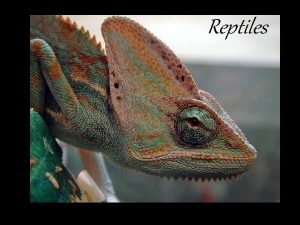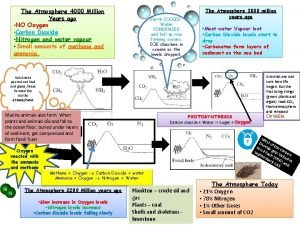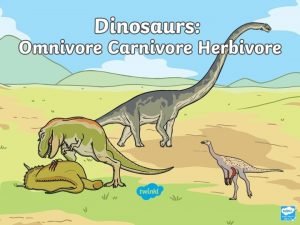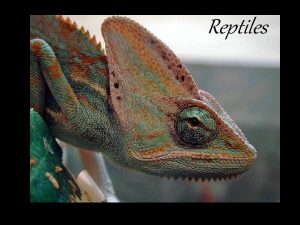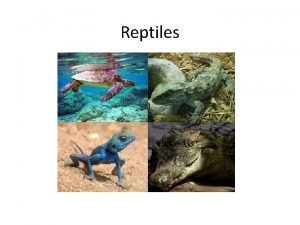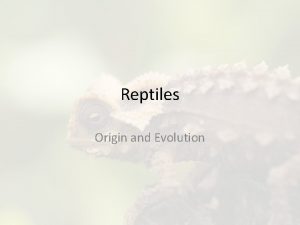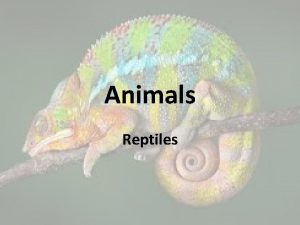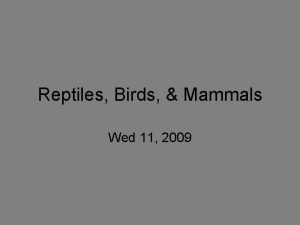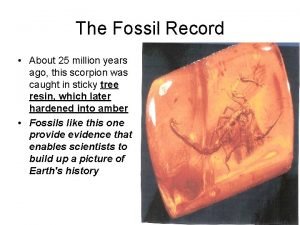Reptiles 310 million years ago reptiles were the


















- Slides: 18

Reptiles

310 million years ago… reptiles were the first vertebrates to make the complete transition to life on land

Adaptations to Land

Amniote Egg

Waterproof Skin • dry body covering of horny scales or plates – prevent water loss – protect from wear and tear associated w/ living in rugged terrestrial environments – unlike amphibians who can’t be far from water or they’ll dry out

External Structural Adaptations (for land) • • • some limbs have toes w/ claws – permit to climb, dig, and move in various terrains others have toes modified into suctions cups – aid in climbing absence of limbs – snakes use scaly skin and highly developed skeletal and muscular systems

External Structural Adaptations (for land) • some limbs have toes w/ claws – permit to climb, dig, and move in various terrains • others have toes modified into suctions cups – aid in climbing • absence of limbs – snakes use scaly skin and highly developed skeletal and muscular systems

Respiration • Well developed lungs (not gills) – tissues involved in gas A. Respiration exchange area located inside body – - kept moist in even driest environments

Temperature Regulation • • metabolism rate controlled in part by body temperature Ectothermic (cold-blooded) – body temp controlled by environment not endothermic (warm-blooded) regulate their temp by behavior – bask in sun to speed up metabolism – hide in shade to prevent overheating

Modern Reptiles • Reptiles are classified into 16 orders, 12 that are extinct. - 4 surviving-6, 000 species • Reptiles occur worldwide except in coldest regions - Human intervention-major impact • 4 living orders of Class Reptilia: - 1. Rhynchocephalia, - 2. Chelonia, - 3. Crocodilia, - 4. Squamata

Rhynochocephalia • Only living speciesthe tuatara - Inhibit islands of coast of New Zealand - Resembles a large lizard about 60 cm long

Rhynochocephalia • - Has an inconspicuous third eye on top of its headparietal eye- functions as a thermostat- protects from overheating - Active at low temperatures and feed at night on insects, worms and small animals

Chelonia • Order consists of about 265 species of turtles and tortoises - Tortoise are terrestrial Chelonia (Galapagos tortoises) - Turtles- chelonians that live in water - Body covered by a shell made of hard plates 2

Crocodilia • Order composed of 20 species of large lizard-shaped reptilescrocodiles, alligators, caimans and gavials • Crocodilians live in or near water in tropical/ subtropical regions of the world • -

• Carnivorous- hunt by stealth- features adapted for this behavior - Eyes on head, nostrils on top of snout -see and breathe while in water - Valve to prevent water from entering air passage - Parental care- both parents care for young by carrying in jaws until development

Squamata • Order consists of 5, 640 species of lizards and snakes - Loosely jointed upper jaw and paired reproductive organs in males - Structurally diverse • Lizards- presence of limbs • -

Squamata • - Common lizards- iguanas, chameleons, skinks and geckos - Live everywhere except Antarctic - Special adaptations- agility and camouflage - 2 species are venomous- Gila monster (SW U. S. ) and beaded lizard (western Mexico) - Most prey on insects or small animals

- - Most lizards are small. 3 m in length; iguanas 1 m in length - Largest lizardsmonitors- Komodo dragon (Indonesia) 3 m (9. 8 ft) in length, 140 kg (308. 6 lbs) - have a forked tongue for sense organs - Consume prey whole and use tail as defense weapon
 310 million years ago
310 million years ago The earth 200 million years ago
The earth 200 million years ago Evolution the beginning
Evolution the beginning 4000 million
4000 million 4600 million years ago
4600 million years ago Four score and twenty years ago
Four score and twenty years ago Iras bagels
Iras bagels On kawara one million years
On kawara one million years Five thousand years ago
Five thousand years ago Apatosaurus herbivore carnivore
Apatosaurus herbivore carnivore How long is four score and seven years ago
How long is four score and seven years ago 125 years ago today
125 years ago today Saturn 4 billion years ago
Saturn 4 billion years ago Shenzhen 30 years ago
Shenzhen 30 years ago Andre courreges biography
Andre courreges biography Technicom 15 years ago as a small
Technicom 15 years ago as a small 4 000 years ago
4 000 years ago Four score and seven years ago our fathers
Four score and seven years ago our fathers Story once upon a time there was a king
Story once upon a time there was a king
